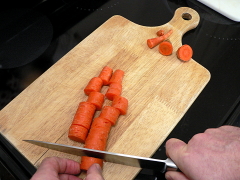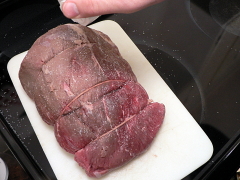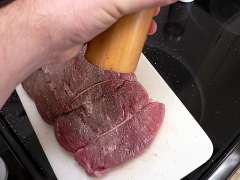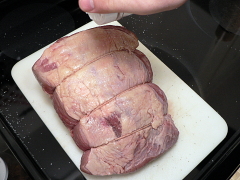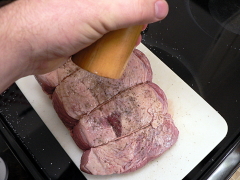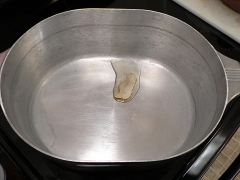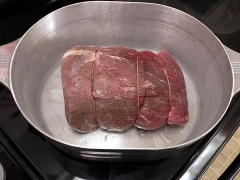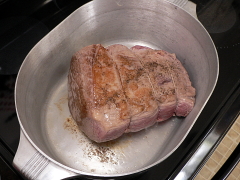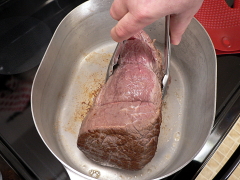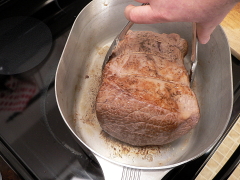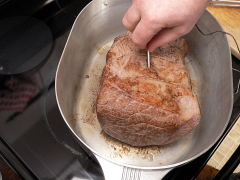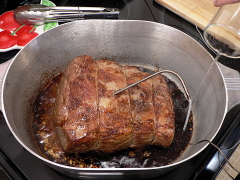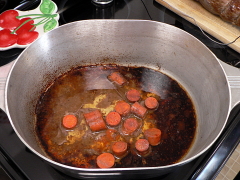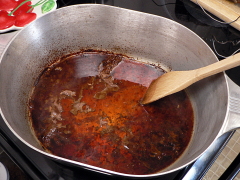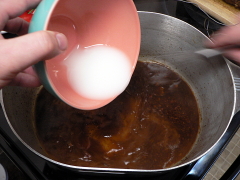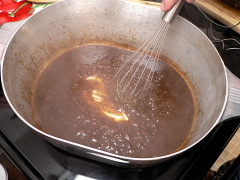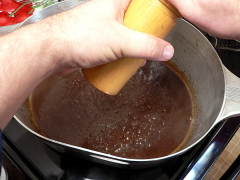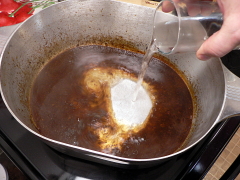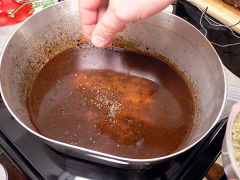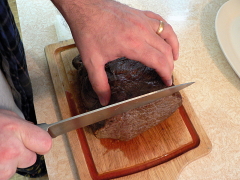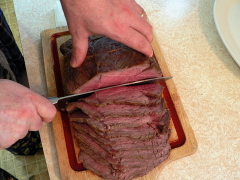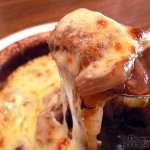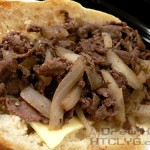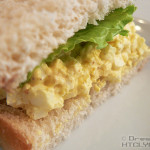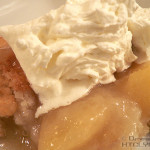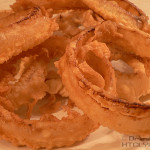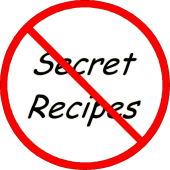Why is it a whole beef roast might cost as little as $4 per pound but the same thing, sliced thin and called “cold cuts”, is suddenly at least $6 per pound? Is slicing it that hard?
Not really. Of course you have to roast it first. Which means you get a nice Sunday dinner out of it, and use the leftovers for sandwiches. Like you’re supposed to.
(Oh, and did I mention you get gravy this way? Can’t forget the gravy.)
Ingredients

5 pound beef round roast
kosher salt
fresh ground black pepper
two large carrots or potatoes
2 tablespoons bacon fat or oil
Directions
Prep
The carrots — or potatoes — are just to hold the beef up off the bottom of the pan. Cut the stem and root ends off, and chop into one-inch pieces.
Put a generous coating of salt and pepper all the way around the roast. “Generous” doesn’t quite mean you can’t see the beef through the salt, but it might seem that way if you’ve been avoiding salt. (Which also means you’ve been avoiding flavor.) Let it rest for about 15 minutes to allow the salt to draw some juices to the top. This is what will caramelize, making lots of flavor for the gravy.
Notice the long fibers running from end to end. I’ll mention those again later.
Cook
Melt the bacon fat over high heat in a roasting pan.
Sear the roast for about a minute or two on each surface. Just long enough to brown it. Don’t worry about trying to “seal in the juices”. That doesn’t actually work. We’re just going for flavor here.
Put your carrots or potatoes in the center of the pan, and place the roast on top.
Insert the probe from your digital thermometer — you do have a digital thermometer, don’t you? — down at an angle into the center of the roast. Place the lid on top, being careful not to pinch the wire from the probe too tightly.
Set the thermometer for 100°. This will give you plenty of warning that the roast is nearly done so you can adjust the stove to finish when you want.
Put the roasting pan in the stove set to the lowest setting it will hold. Mine only goes down to 170°. You can see in the picture above that my roast started at 33°, and it was up to 68° within just over an hour. That was way too fast.
I turned the stove off but left it closed. After about an hour I turned it back on, but set the timer to shut off after a half-hour. I repeated this cycle several more times, shooting for an internal temperature of 140° when it hit the table at 5:00.
When I pulled it at 4:00, it was just under 130°. Always pull a large cut of meat well before it’s at the target temperature. It will keep rising for quite a while.
You could just let this rest and carve it, but it’s better with a crust. Turn the oven up to 500° and return the pan for about 10 minutes, until there is a nice crispy finish.
Gravy
Pour about a cup of water into the roasting pan while it’s still hot to break all the cooked-on juices loose from the bottom.
Take the beef out and set it on a cutting board to rest. Mine was at 137° now. Remove the carrots or potatoes and scrape up everything from the bottom of the pan with a wooden spoon or a whisk.
Mix about a tablespoon of cornstarch with cold water. It has to be cold or you’ll get lumps. Pour the starch mixture in slowly while whisking constantly over high heat.
Bring the gravy to a boil and add pepper.
This didn’t look like enough gravy for four people, so I added more water. Toss in a couple of teaspoons of cardamom.
Since I added more water, I added another round of cornstarch. Bring it back to a boil, whisking constantly. You need to boil for at least one or two minutes or it won’t thicken up when you remove it from the heat.
Serve
Now that the gravy is done, the temperature of the roast should have stabilized. Mine topped out at about 148°. A bit above what I wanted, but close enough.
Slice very thin slices across the grain. Remember up top when I pointed out the long fibers? If you leave them long, the meat will be chewy and stringy. You want to cut them into the shortest lengths possible.
Keep all the slices in line with the rest of the roast. Lift everything at one time onto your serving plate.
Bring it to the table with the un-sliced end on the platter. It makes for a nicer presentation.
Add mashed potatoes and corn, and that’s it.
Tomorrow I’m going to borrow the mini meat slicer from my father-in-law to turn the rest into cold cuts. I’ll try to remember to take some pictures.



